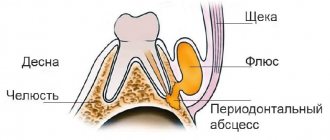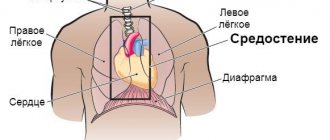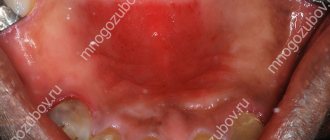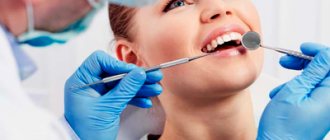The depulpation procedure involves removing soft tissue from the tooth canal, which ensures the absence of any pain. It can be carried out during the treatment of dental diseases or in preparation for further prosthetics. How then to explain the situation when a pulpless tooth hurts when biting? Where do the unpleasant sensations come from if there is no pulp at the root? The reasons may be related to external and internal factors, as well as false signals coming from neighboring hard or soft tissues.
Content:
- Can a tooth hurt after nerve removal?
- When to sound the alarm
- Reasons why a “dead” tooth hurts
- How to deal with pain in a pulpless tooth
Nerve extraction is a fairly common dental procedure.
It is not complicated. The dentists worked it out to the smallest detail. Most often, the patient does not even experience any discomfort. After all, highly effective anesthetics are used during depulpation. After removal of the nerve, the tooth may hurt for two to three days. Then, normally, the pain disappears on its own. If pain symptoms persist longer, it is recommended to visit the doctor again. It is possible that previous treatment of pulpitis led to complications.
Prevention
If you have dead teeth, care must be taken to preserve them. A crown that does not receive nutrients is fragile. Over time, it can deteriorate and tooth mobility appears. Prevention of diseases in such diseases is very important.
It is imperative to ensure proper daily oral hygiene. Teeth should be brushed with a suitable toothpaste; the brush should not have very hard bristles. After eating, you need to rinse your mouth with special compounds. This will help get rid of food debris and minimize the risk of developing plaque, tartar, and the proliferation of pathogenic microorganisms.
It is important to undergo regular examinations by the dentist, and at the first appearance of pain or signs of disease, immediately go to see a doctor for diagnosis and treatment.
Can a tooth hurt after nerve removal?
The pulp is a thin bundle of nerves, blood vessels and ligaments. It fills the entire internal cavity of the tooth. The condition and sensitivity of the unit, the strength of the enamel layer and even the color of the enamel depend on it.
Due to advanced inflammation, damage to the pulp zone occurs. Then pulpitis develops. Subjectively, a person feels it as an acute pain that appears during temperature changes and mechanical impact. To prevent further spread of the inflammatory process, the doctor removes the inflamed pulp, cleans the dental canals and covers them with filling material.
After depulpation, the tooth stops responding to stimuli. That is, in fact, he should not be sick. However, people often come to the dental clinic complaining of pain in the pulpless unit. With what it can be connected?
Indications for root canal treatment
Acute throbbing pain in a tooth is a marker of inflammation. Against this background, the following symptoms should alert you:
- swelling of the gums and cheeks;
- flux formation;
- reaction to temperature stimuli;
- fever, chills;
- increased pain when biting.
Clinical manifestations are a reason to return to the dentist, otherwise there is a high risk of losing a dental unit. If defects are detected, repeated radiography, removal of the filling, cleaning and obturation of the canal are necessary.
When to sound the alarm
Mild soreness after nerve tissue removal is normal. After all, the canals are expanded, their shape is changed in order to be densely filled with a filling compound.
Mild discomfort that persists in the first few days is what doctors call post-filling pain. It does not require special treatment. If necessary, the patient can take painkillers.
During the depulpation procedure, microtraumas are inevitable. The tissues need to be given time to recover. Within two or three days there will be no trace of post-filling discomfort.
This is what the symptoms look like, indicating that the regeneration processes are not going according to plan:
- the pain persists after five to seven days, it is sharp, severe, and interferes with leading a normal lifestyle;
- analgesics do not relieve symptoms immediately and for a short time (sometimes they are completely useless);
- body temperature is increased;
- the gums in the area of the problem unit become inflamed and swollen;
- headache;
- the pain spreads to neighboring teeth, sometimes it is difficult to understand which zone is its source.
With these signs, you need to determine the cause of the problem as soon as possible. To do this, you should seek medical help. The doctor will conduct a diagnosis and tell you what to do to speed up regeneration.
Reviews about depulpation
Many people are familiar with the depulpation procedure. And yet reviews say that it usually causes pain, which very soon disappears on its own. In this case, inflammation does not begin so often. For most people who have undergone this procedure and published their opinions about it, the pain subsided within a day or two, given the use of drugs designed to combat it.
Reasons why a “dead” tooth hurts
Most often, the complication is associated with poor quality work by the dentist. It is very important to treat the canals correctly. There should be no air pockets left in them. Otherwise, very soon pathogenic microorganisms will penetrate there and begin to actively multiply.
Among the most common causes of pain after depulpation:
- Incomplete closure of dental canals. Such a medical error does not make itself felt immediately. At first the patient enjoys a healthy smile, but at some point the situation changes. Sometimes poor-quality filling results in the formation of a cyst or granuloma. These are quite dangerous complications.
- The installed filling extends beyond the boundaries of the root. Painful symptoms occur when pressure is applied to the treated area. Excess paste puts pressure on the jaw bone and irritates it. As a result, the inflammatory process is activated. The greater the volume of excess material, the more pronounced the negative symptoms.
- The presence of a fragment of a medical instrument at the root. Fortunately, this doesn't happen often. The products used by the doctor during depulpation are very thin. They need to be able to manage. It is unacceptable to put too much pressure on them. Any inaccurate movement and the lower part of the instrument remains in the channel. By the way, this can also happen due to the patient’s fault if he is constantly fidgeting and closing his mouth when this is strictly forbidden. Until the fragment is removed, the pain will not go away.
- Perforation or disruption of the integrity of the tooth root wall. It is a consequence of careless use of endodontic equipment. Due to the action of the anesthetic, a person may not feel that a transformation has occurred. But this state does not come without a trace. It requires mandatory correction. Through the artificial cavity in the root, the filling agent can penetrate to the border of the jaw bone. Then the latter will become inflamed.
- Personal intolerance to the embedded material. We are talking about an allergic reaction. You can never know in advance how a particular person’s body will react to antiseptics or a filling. With allergies, soon after depulpation the patient begins to feel aching pain. Burning and redness of the gum mucosa is also possible. In case of a severe allergic reaction, the eyes become watery and nasal breathing becomes difficult. Body temperature may also increase.
Any of the above reasons is a reason to get dental care as soon as possible. By postponing a visit to the doctor until later, a person risks his health.
What measures to take?
If the pain is too severe, you need to visit the dentist as quickly as possible, who will help you find out the cause. If he decides that the cause of the pain lies in the body’s reaction to the filling, additional therapy will be prescribed, and more specifically, the use of anti-inflammatory drugs. Thanks to this, the patient recovers much faster.
If the pain is the result of improper depulpation and poorly sealed canals, the therapy is more complicated. And most often it lasts a long time.
ethnoscience
In the case of mild but gradually decreasing pain, alternative therapy is acceptable. Before using various folk remedies, you should consult your doctor. If he approves the use of traditional medicine, it may be beneficial in getting rid of the remaining inflammation.
Here are simple and effective recipes:
- take fresh juice of Kalanchoe leaves or, alternatively, angelica root, moisten a cotton ball with it, and apply to the gum for ten minutes. If necessary, do the same several times every two to three hours;
- put a mixture of chamomile and elderberry flowers in a 1:1 ratio in a small gauze bag, which is then applied to the tooth and gum;
- take one and a half to two tablespoons of St. John's wort per glass of boiling water, make an infusion. Moisten a cotton wool with it and apply it to the sore spot. Dilute part of the infusion with water in a 1:1 ratio;
- make an infusion: 50 g of birch buds, which will be about four to five tablespoons, for half a liter of vodka. Everything should be infused in a warm place for ten days. This tincture can be prepared for future use. Usage: moisten a cotton swab with tincture, apply for ten minutes;
- pour a couple of tablespoons of finely chopped oregano into 300 ml of sunflower oil, let stand for 8 hours, then strain and squeeze. Moisten the cotton wool and press it onto the sore spot;
- Make a decoction of snake rhizome in the proportion of a tablespoon to a glass of boiling water. The result is to rinse your mouth;
- make a decoction of oak bark in the proportion of 6 tablespoons per liter of water, add a couple of tablespoons of sage leaves at the end of boiling. The recipe is intended for mouth rinses;
- take an equal number of sage leaves and chamomile flowers, or, alternatively, one of these plants. Prepare an infusion, keeping the proportion of a tablespoon of each plant per glass of water. This product is also a mouth rinse.
Attention ! If the pain has become easier or even gone completely, this does not mean that the tooth is now completely healthy. With all the advantages of traditional medicine, if you have a toothache, you still need to immediately consult a dentist.
Only trusted doctors can guarantee the absence of excessive pain after depulpation, as well as careful compliance with all their recommendations, and especially the requirements during the rehabilitation period. But if discomfort occurs, you should visit the doctor again.
Antibiotics
If there is no positive result when using other drugs, the doctor prescribes a course of antibiotics. Of these, Lincomycin is most often used in dentistry. This remedy is useful if, during filling, pathogenic bacteria have entered the tooth cavity and this has caused inflammation. Even if antibiotics are powerless, only a last resort can help, which is opening the filling and cleaning the tooth again.
How to deal with pain in a pulpless tooth
You'll have to sit in the dentist's chair again - there's no way around it. Repeated treatment usually consists of the following stages:
- Inspection and diagnostics to determine the cause of the problem. Most often, it is very easy to get answers to all the questions that arise - the patient is asked to take an x-ray. It shows the condition of the roots and the quality of canal filling. Also, from the image you can recognize the fragments of instruments forgotten by the would-be doctor. If radiography does not reveal any abnormalities - the unit is healthy, like its neighbors - the development of allergies can be assumed. Then the patient is asked to donate blood for allergens.
- Eliminating the cause of pain. Most often, to do this, the doctor removes the previously installed filling compound, opens the cavity of the dental canal and corrects the mistakes made. If the canals were processed poorly, they are sealed again. If the material extends beyond the top, the excess is removed. If there is a perforation on the face, it is covered with a special material. If there is debris, it is removed. In the case of allergies, repeated treatment must be carried out, but with the use of other medications.
- Canal filling. As soon as the negative influence of the provoking factor is eliminated, the doctor will close the dental canals and carious cavity. After this, he will conduct x-ray diagnostics again to make sure that everything is normal with the patient.
It is important to understand that even after repeated treatment, pain symptoms may still persist for some time. This is due to the occurrence of regeneration processes. You should be patient and strictly follow all medical prescriptions. If the doctor has prescribed antibiotics or some kind of anti-inflammatory drug, you must take it.











